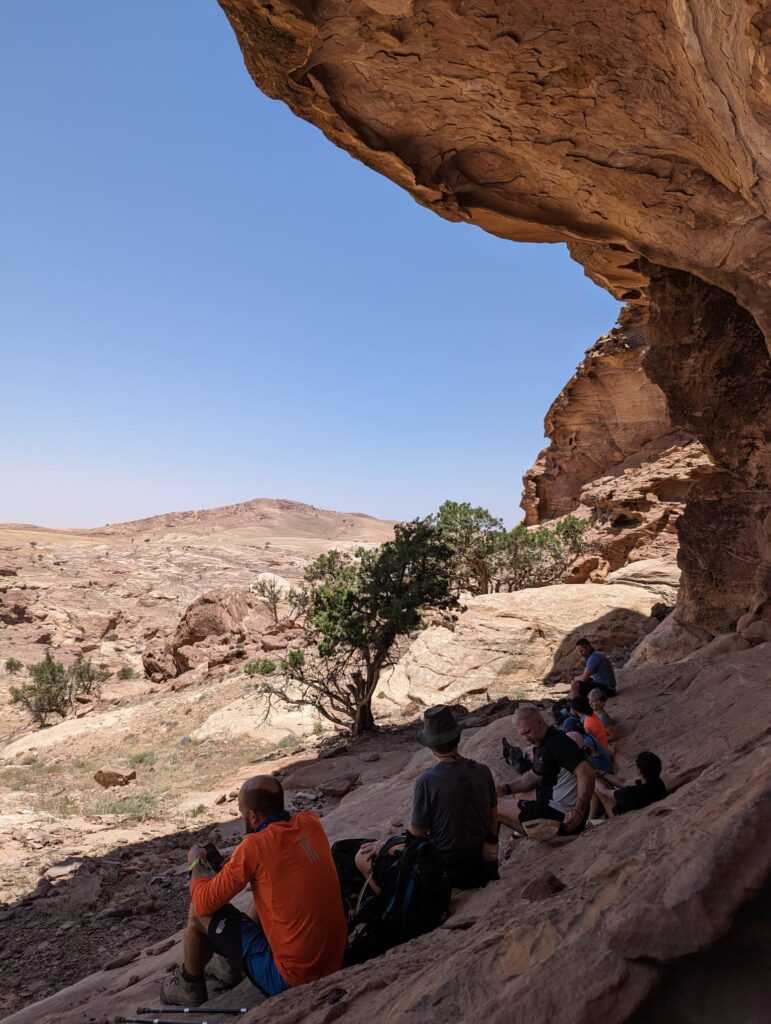As the weather heats up, we start dreaming of desert treks and camping under the stars. We know a lot of you do, too. Mainly because we begin receiving more enquiries about desert trekking and the clothing and equipment required.
How do you dress for those hot and sandy days? What items will keep you cool and comfortable? How do you protect yourself from the extreme environment?
Fortunately, our resident desert expert, Rolfe, is here with his top tips for styling it out in the dunes.
Building a desert kit list
When it comes to mountain sports, the adventure clothing industry covers all bases. Whether hiking in the UK or battling winter storms in the Himalayas, a clothing system is available for every mountain environment and all eventualities.
The growing popularity of outdoor apparel and mountain-wear means putting together a cold-weather mountain kit list is relatively straightforward. Like many adventure travel companies, 360 provides kit lists for all our mountain expeditions. They help you navigate the various brands, styles and materials on offer and give you an idea about how suitable items are for specific expeditions. Because of the ubiquity of mountain clothing and equipment, you will probably recognise most brands and products on those lists.
But things are a little different for other trekking environments. Desert apparel has not hit the mainstream in the same way and most people are a lot less familiar with the type of clothing and equipment you require for the desert environment’s equally quirky and extreme conditions. Thankfully, the clothing required for desert adventures like our Sahara, Sinai or Jordan expeditions is simple, relatively inexpensive and easy to find.
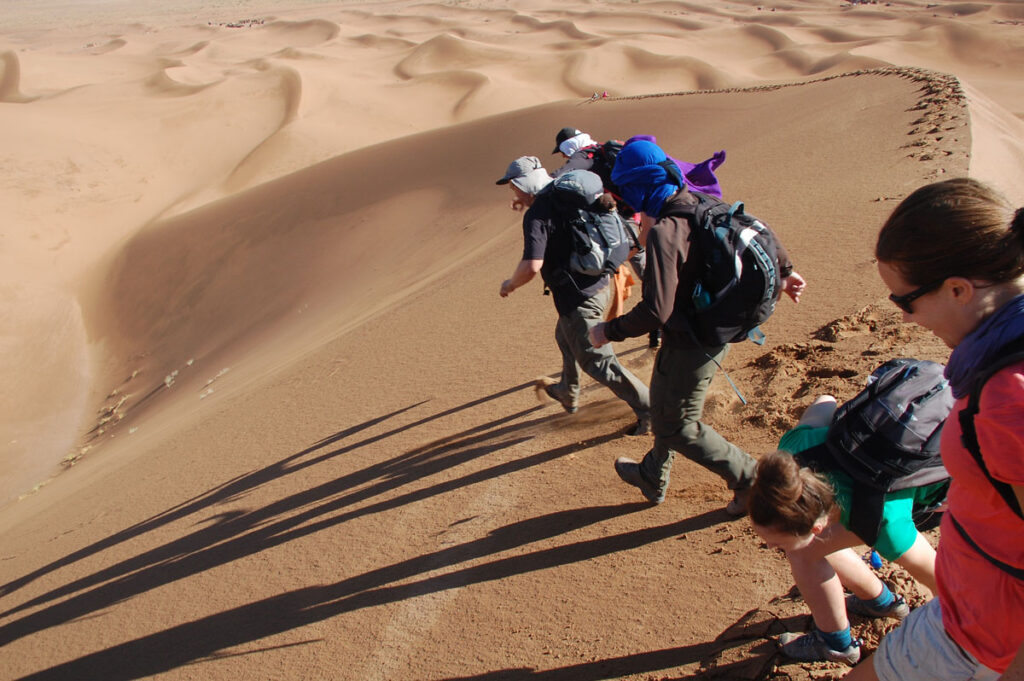
Understanding the desert environment
In the desert, the primary environmental hazard is the sun. However, sand, wind and considerable temperature swings from day to night are also a significant challenge and potential dangers. Crucially, these potential hazards can reach extreme levels.
For example, the 360 Expeditions team faced our highest-ever temperatures during a Sahara challenge, when the mercury hit 52°C! We encountered the strongest winds as we trekked through an enormous wadi in the Sinai desert, sheltering as sand swirled around us. The most extreme temperature swing occurred in Wadi Rum in Jordan, where it dropped from 47°C to 4°C within 24 hours. Fortunately, we were well dressed and prepared in every instance.
Dressing for the desert – the basics
Dressing for the desert is pretty simple. Google Lawrence of Arabia and you will get the basic idea! In the desert, you will also usually see the hardy local Bedouins dressed in long, loose-fitting robes that cover them from head to toe. So, is that what you need to look for?
Not exactly. Rather than trying to imitate the locals exactly, the most important thing is to learn from their example. Your key takeaway? Cover up well with loose clothing.
Head and neck
Starting at the top, we recommend wearing a large-rimmed, lightweight hat. Caps are ok, but they expose your ears, mouth and cheeks to the sun. You can find a range of suitable hats on the market. Some have ventilation holes on their sides, some include chin straps and some integrate pockets and other features. The best approach is to try a few different designs and figure out what fits and works best for you. Moving down, a loose-fitting buff around your neck will absorb sweat and you can pull it up to act as a dust barrier for when the wind picks up.
Category 3 or 4 sunglasses are also necessary, as the desert can be remarkably light and bright. These categories benefit from a dark or very dark tint and a low Visible Light Transmission Score (VLT), ensuring they block out more light. Sunglasses are not just for the light, though. They will also protect against sand kicked up by strong winds and are essential in sandstorms.
A shawl or light scarf is an excellent and incredibly versatile addition to your desert kit list. Not only can you use them to protect your face from the sun and wind, but you can also utilise them to create extra shade when you pause for your afternoon break.
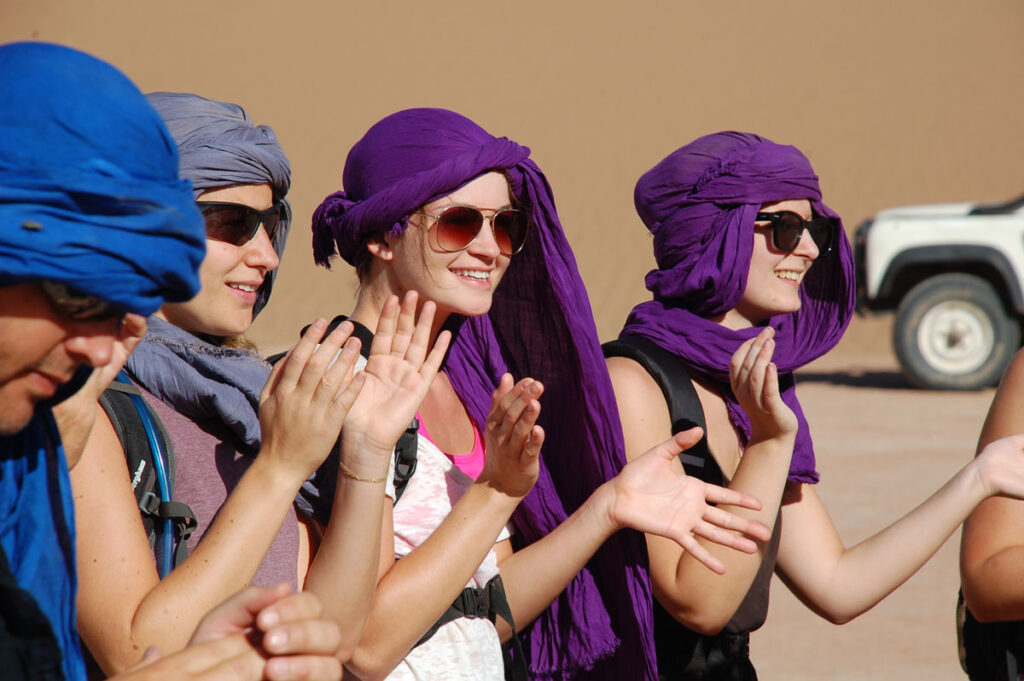
Upper body
For your torso, we suggest a light-coloured, loose-fitting, long-sleeved cotton shirt or top. Air must circulate freely and the material should be both quick-wicking and quick-drying. Personally, I like thin cotton, as it dries quickly and is more comfortable. The lighter the colour, the better, as dark clothes absorb the sun’s rays and retain more heat.
It might sound odd for such hot weather, but keep a warm fleece and beanie in your rucksack. Often, as the sun sets, the temperature fluctuations catch people out and they get chilly. Luckily, our desert crews light warm campfires most evenings to cook, dry clothes and keep us warm as we sit around and reminisce about having spent another awesome day in another awesome place…
Legs
On your legs, we prefer loose-fitting, long trousers. The trekking trousers commonly used on treks like the Inca Trail, the lower slopes of Kilimanjaro and most sub 4,000-metre Himalayan expeditions, work well. They must keep the sun off your legs. But they should also stop the abrasive effects of wind-scattered sand and minimise invasion from insects and spiky vegetation. I wear Navigator Trousers by Berghaus. When pencilled in for a lot of desert work, I generally get a pair that are a little larger than usual and use a belt to hold them up. My only issue with them is that they only come in dark colours. And, as we already mentioned, light-coloured clothes reflect the sun’s rays better and are cooler to wear.
You can wear shorts and T-shirts if you prefer (the zip-off style trousers work well in this case). But you must be vigilant about sun protection. I prefer trousers because they keep me cooler, I don’t have to worry about the sun on my legs, and they prevent sand and dust from sticking to sweaty, exposed skin. Also, if the locals are completely covered, it is probably a good idea. When in Rome and all that…
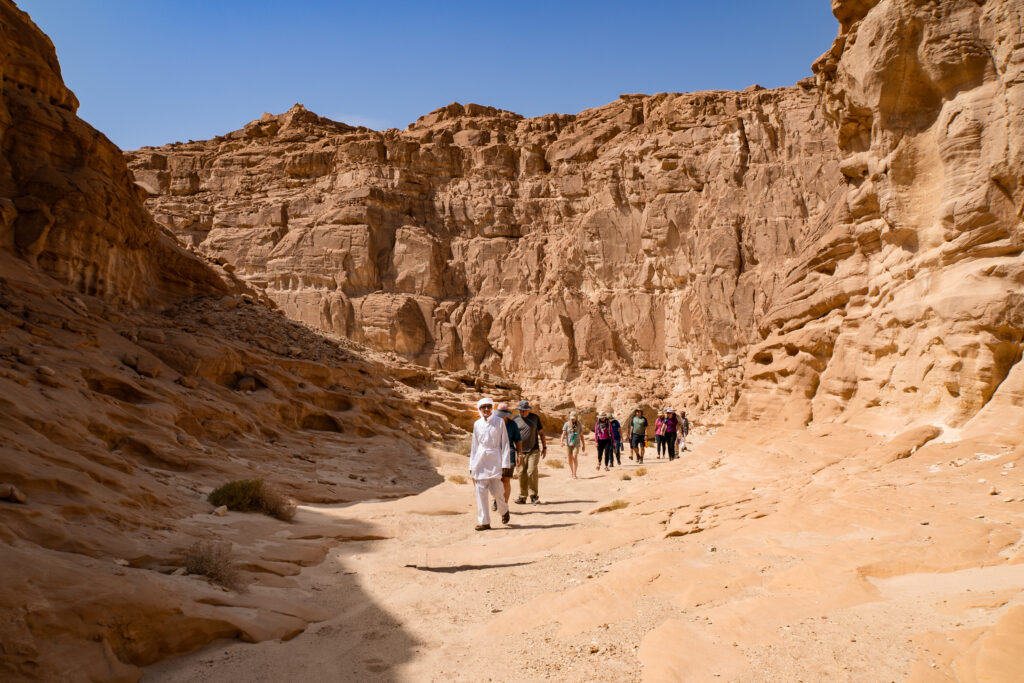
Footwear
The Bedouins of the Sinai and Jordan and the Sahara Berber will often wear flip-flops. But this is the perfect example of why you should not copy the local dress to a detail. They have a lot of experience walking in the desert and, just as Sherpa can handle altitude, desert dwellers are well adapted to walking sand and rocky terrain in sandals.
Think about your experience of sunny beaches. Now, imagine walking up and down the softest, hottest and driest part of your nearest beach from 7 am to 5 pm (with a break for a few hours at midday under a palm tree in your local oasis) for five or six days straight. The biggest concern is blisters from the fine sand continuously rubbing your soft, sweaty feet. Sand and rough rocky terrain can tear your feet apart. Especially when heated to 40°C or more.
The best way for us to comfortably walk in a desert is to wear a thin pair of socks inside well-worn, ankle-high boots. If they are Gortex and wick moisture, that is great news for your feet. If you own a pair of loose-fitting gaiters to cover your boots, even better. The idea is to keep the sand out and your feet dry and protected from the rough terrain. 360 Expeditions desert guides stop our teams regularly to check our feet. Hotspot forming? We treat any rubbing marks before they turn into a blister. We also encourage our teams to wear a clean, dry set of socks for the next day of trekking.
In some instances, sports sandals are an appropriate option (our Sinai expedition, for example). However, we would not recommend them to anyone trekking in the desert for the first time. Old-style, heavy trekking boots are not recommended either. They really do not get on well with the desert sand.
Carry pack or daysack
On most 360 expeditions, you will carry your own daysack. It contains all you need for the actual trekking component of the day, including your food, water and any extra bits and pieces you may require immediate access to. In general, your carry pack should weigh no more than three or four kilograms and be no larger than a 30-litre capacity. Also, make sure the daysack features an adjustable waist belt that redistributes the weight to your hips. This ensures your strongest muscles shoulder most of the burden.
Most days, you will use your daysack to carry a light fleece, water for the day, snacks, camera equipment, a personal first aid kit, any necessary medication, a scarf or shawl for the sun and wind, sun protection and a head torch.
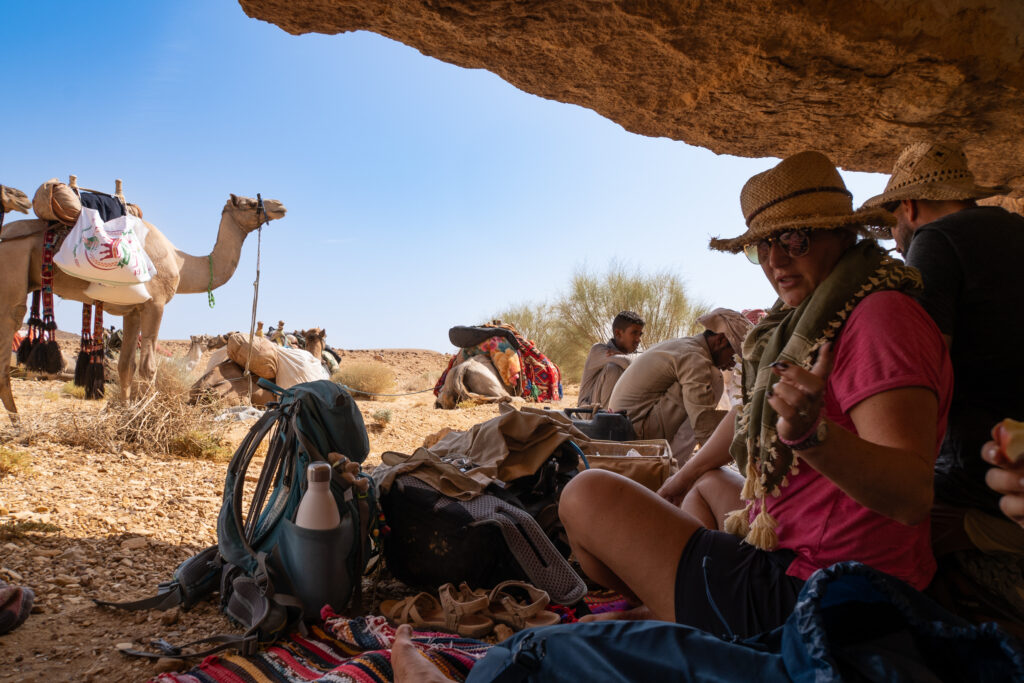
Food and water
Unsurprisingly, sourcing water is not always that easy in the desert. On 360 expeditions, we leverage local insight to ensure trekkers stay hydrated. In many cases, camels carry the water supplies, which the guides replenish at mountain springs and wells.
The food you carry for your mid-trek snacking needs must also be well-suited to the climate and conditions. For instance, chocolate is not the best choice, considering the heat. We typically recommend protein-rich snacks, such as biltong or a veggie equivalent, as they help repair muscles and aid recovery while making you feel full and satisfied. Electrolytes and salts are also great to bring. Replacing all those essential salts you lose through extensive sweating can make a real difference.
Most trek providers will ensure you are well-fed during your experience. And 360 Expeditions is no different. On our desert treks, we prioritise simple, fresh food cooked in a local manner. On our Sinai Expedition, that means sitting around the campfire with our Bedouin guides as they prepare traditional Bedouin bread, lentil soups, babaganoush, rice and foul (Egyptian beans). But you also need to be able to sustain yourself between meals. Consider your options well in advance and remember the golden rule of expedition nutrition – never rely on a snack or food you have yet to test and try.
Extras and accessories
If you are carrying electronics or camera equipment, take care not to allow sand to work its way into your devices. Unsurprisingly, sand seems to get everywhere in the desert and, if you are not careful, it can wreak havoc on your gear. Fortunately, there is a simple fix. Zip-loc bags. Keep everything sealed away when not in use and be extra careful when using devices and you should be absolutely fine.
Finally, a word on sunscreen and other types of sun protection products. We recommend using sunscreen and lip balm throughout your desert trek. Reapply regularly. A broad-spectrum sunscreen with an SPF of at least 30 should be sufficient, though you may want a higher rating if you are particularly prone to sunburn.
Desert trekking with 360 Expeditions
All the information provided in this guide to desert clothing and equipment is the product of extensive, first-hand experience. At 360 Expeditions, we have organised desert treks for more than a decade, putting us in a fantastic position to offer advice and guidance on how you can get the most from your desert adventures.
Currently, our Sinai Summit to Sea Expedition and Jordan Desert Trek to Petra Expedition rank among some of our most popular treks. Not only do they offer unforgettable insight into the magic of desert landscapes and the beauty of these extreme environments, but they also provide an opportunity to engage with the people and cultures that call these places home. They know more than anyone else what it takes to move through, live in and appreciate the desert. And they are happy to share that expertise and lived experience.
Dream it, plan it, live it! We’ll see you on the dunes…
